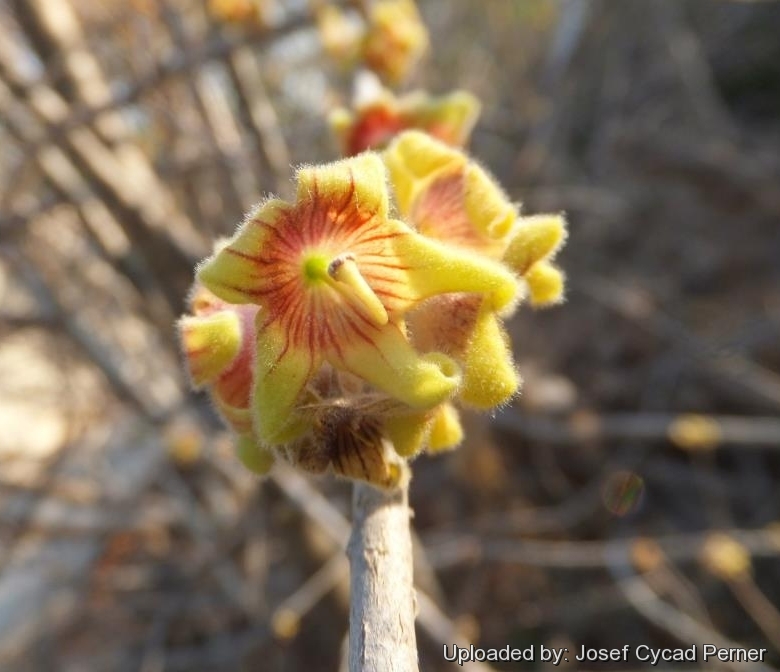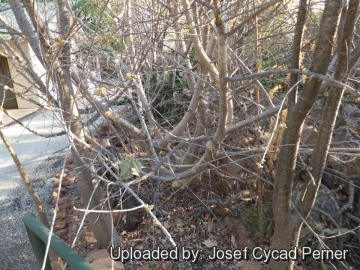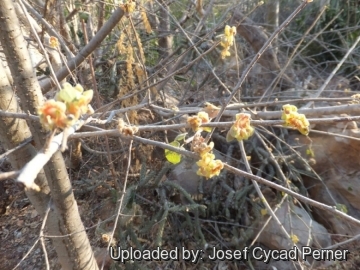




Your support is critical to our success.
- Encyclopedia of SUCCULENTS
- Encyclopedia Index
- Families
- Genera
- Species
- Sterculiaceae
- Sterculia
- Caudiciforms
- Trees
Since 4 Aug 2013

Origin and Habitat: South Africa (Transvaal, KwaZulu-Natal), Swaziland, Botswana, Zimbabwe, South Mozambique
Habitat and ecology: Sterculia rogersiiSN|31890]]SN|31890]] is a very characteristic species of dry woodland and bush in the Limpopo valley and adjacent areas, usually in sandy soils on the Plains of Mixed Bushveld or in rocky river gorges or on dry rocky outcrops mostly on North- or West-facing Slopes. It grows singly, and may be the only tree on a rocky outcrop. Birds, game and stock eat the seeds of this tree. Elephants are very fond of the young shoots and roots. The leaves and young stems are eaten by browsers such as antelope.
Synonyms:
- Sterculia rogersii N.E.Br.
ENGLISH: Star-chestnut, Common Star Chestnut
AFRIKAANS (Afrikaans): Sterkastaiing, Gewone Sterkastaiing
SOTHO (NORTHERN) (Sesotho sa Leboa / Sepedi): Mokgwakgwatha
TSONGA (xiTsonga): Samani, Nsolodza
TSWANA (Setswana): Mokakata
VENDA (Tshivenḓa / Luvenḓa): Mukakate
ZULU (isiZulu): inKhuphenkhuphe
Description: Sterculia rogersiiSN|33502]]SN|31890]] is a small thickset tree or natural bonsai up to 5-6 m tall with rather slender branches and often branching low down, with smooth bark flaking to reveal reddish to purple or yellowish under-bark and a characteristic thickset trunk. The tree flowers for quite a long time, and the small bell-shaped flowers, normally borne in clusters, are fuzzy, saucer-shaped, showy yellow with radiating red streaks carried on the old wood and young branches, making it a very interesting garden subject. This plant is considered by same a pachycaul succulent, during his youth - in plants grown from seed - the base of the trunk takes a caudiciform/succulent shape. Because of its stout trunk and thin branchlets, this tree is sometimes mistaken for a young Baobab (Sterculia rogersiiSN|33502]]SN|31890]]) is a small thickset tree or natural bonsai up to 5-6 m tall with rather slender branches and often branching low down, with smooth bark flaking to reveal reddish to purple or yellowish under-bark and a characteristic thickset trunk. The tree flowers for quite a long time, and the small bell-shaped flowers, normally borne in clusters, are fuzzy, saucer-shaped, showy yellow with radiating red streaks carried on the old wood and young branches, making it a very interesting garden subject. This plant is considered by same a pachycaul succulent, during his youth - in plants grown from seed - the base of the trunk takes a caudiciform/succulent shape. Because of its stout trunk and thin branchlets, this tree is sometimes mistaken for a young Baobab (Adansonia digitataSN|102]]SN|102]]), which has smooth, grey bark and large, compound hand-shaped leaves. This unusual tree is very variable with a sparse, irregular canopy, but unmistakable. This tree can be identified throughout the year by its unusual growth form and bark. It is deciduous.
Derivation of specific name: The species rogersii was named after Archdeacon F.A. Rogers, an English missionary and collector of over 24 000 plant specimens.
Stems: The main trunk is and main branches are stout, short and very thick, which divide abruptly into very thin branchlets and twigs. The dark brown to purplish bark are thickset with smooth brown bark peeling in papery flakes and revealing reddish, purple,creamy, yellow-green or yellowish under-bark. The branchlets are grey and papery with a white warty appearance, giving the trunk a distinctive mottled appearance.
Leaves: Simple. They appears singly and alternate or clustered on the ends of new, fast-growing short side-shoots. Lamina up to 3-6 cm long, 2-5 cm wide, very broadly cordate (heart-shaped), ovate (egg-shaped) to rounded entire or very shallowly to deeply sinuately 3–5-lobed (ivy-like), apex obtuse or subacute, broadly tapered, while the base is deeply cordate. The 5-7 veins, which come from the base, are clearly visible. Petiole up to 75 mm long. They are shiny yellowish-green or green, minutely hairy above, whitish and hairy below, 5–7-nerved at the base; petiole up to 2 cm. long, tomentellous. Leaves are borne late in the season and turn yellow in autumn.
Inflorescences: In clusters on the short side-shoots, appearing before the leaves; pedicels up to 5 mm. long, tomentellous, articulated near the middle; bracteoles c. 1–5 mm. long, linear, pubescent, caducous.
Flowers: Star-shaped 10 - 20 mm in diameter, growing at the ends of branchlets and twigs before the new leaves. They are yellowish-green with vertical reddish guide-lines within, red-green on the outside, very similar in size and structure to those of Sterculia africanaSN|33502]]SN|33502]].
Fruits (follicles): Consists of 3 - 5 long lobes that end in a long, horn-like point each lobe up to 7–5 cm long, oblong-ovoid, chestnut-like, spreading, subsessile, apical horn up to 1.3 mm long. Each fruit turns from green or pale yellow to greyish-pink or golden-brown when ripe, hairy outside, pale and hairy inside. When ripe they split open on the tree to release approximately 10 seeds through a gap lined with golden stinging hairs.
Seeds (capsules): Numerous, grey smooth, like those of Sterculia africanaSN|33502]]SN|33502]] star-shaped velvety, but only 1–1.3 × 0.7 cm
Phenology: The flowers usually appear before the leaves from about June to December in clusters on the bare branches. The fruit capsules start appearing from September and ripen towards March. }}), which has smooth, grey bark and large, compound hand-shaped leaves. This unusual tree is very variable with a sparse, irregular canopy, but unmistakable. This tree can be identified throughout the year by its unusual growth form and bark. It is deciduous.
Derivation of specific name: The species rogersii was named after Archdeacon F.A. Rogers, an English missionary and collector of over 24 000 plant specimens.
Stems: The main trunk is and main branches are stout, short and very thick, which divide abruptly into very thin branchlets and twigs. The dark brown to purplish bark are thickset with smooth brown bark peeling in papery flakes and revealing reddish, purple,creamy, yellow-green or yellowish under-bark. The branchlets are grey and papery with a white warty appearance, giving the trunk a distinctive mottled appearance.
Leaves: Simple. They appears singly and alternate or clustered on the ends of new, fast-growing short side-shoots. Lamina up to 3-6 cm long, 2-5 cm wide, very broadly cordate (heart-shaped), ovate (egg-shaped) to rounded entire or very shallowly to deeply sinuately 3–5-lobed (ivy-like), apex obtuse or subacute, broadly tapered, while the base is deeply cordate. The 5-7 veins, which come from the base, are clearly visible. Petiole up to 75 mm long. They are shiny yellowish-green or green, minutely hairy above, whitish and hairy below, 5–7-nerved at the base; petiole up to 2 cm. long, hairy. Leaves are borne late in the season and turn yellow in autumn.
Inflorescences: In clusters on the short side-shoots, appearing before the leaves; pedicels up to 5 mm. long, hairy, articulated near the middle; bracteoles c. 1–5 mm. long, linear, pubescent, caducous.
Flowers: Star-shaped 10-20 mm in diameter, growing at the ends of branchlets and twigs before the new leaves. They are yellowish-green with vertical reddish guide-lines within, red-green on the outside, very similar in size and structure to those of Sterculia africanaSN|31890]]SN|33502]].
Fruits (follicles): Consists of 3-5 long lobes that end in a long, horn-like point each lobe up to 7–5 cm long, oblong-ovoid, chestnut-like, spreading, subsessile, apical horn up to 1.3 mm long. Each fruit turns from green or pale yellow to greyish-pink or golden-brown when ripe, hairy outside, pale and hairy inside. When ripe they split open on the tree to release approximately 10 seeds through a gap lined with golden stinging hairs.
Seeds (capsules): Numerous, grey smooth, like those of Sterculia africanaSN|31890]]SN|33502]] star-shaped velvety, but only 1–1.3 × 0.7 cm.
Phenology: The flowers usually appear before the leaves from about June to December in clusters on the bare branches. The fruit capsules start appearing from September and ripen towards March.
Bibliography: References and further reading
1) H. Wild “Flora Zambesiaca” 1961
2) Schmidt,Ernst., Lotter,Mervyn, McCleland. "Trees and shrubs of Mpumalanga and Kruger National Park." Jacana. Johannesburg. 2002.
3) Pooley, Elsa. "The complete field guide to Trees of Natal Zululand & Transkei". Natal Flora Publications Trust c/o Natal Herbarium. Durban 1993.
4) Coates Palgrave, Meg. Keith Coates Palgrave "Trees of Southern Africa." Struik Publishers. Cape Town. 2002.
5) Little, R. John. "A Dictionary of Botany." Van Nostrand Reinhold Company Inc. New York. 1980.
6) Lou-Nita Le Roux, Lowveld National Botanical Garden March 2011 “Sterculia rogersii
N.E.Br.” in: Plantzafrica <http://www.plantzafrica.com> Web. 19 Sep. 2015.
7) Braam Van Wyk, Piet Van Wyk “Field Guide to Trees of Southern Africa” Struik, 1997
8) Rina Grant, Val Thomas, Joan Van Gogh “Sappi Tree Spotting: Bushveld, Including Pilanesberg and Magaliesberg” Jacana Media, 01 January 2005
9) Foden, W. & Potter, L. 2005. Sterculia rogersii N.E.Br. National Assessment: Red List of South African Plants version 2015.1. Accessed on 2015/09/19

Sterculia rogersii Photo by: Josef Cycad Perner

Sterculia rogersii Photo by: Josef Cycad Perner
Cultivation and Propagation: Sterculia rogersiiSN|31890]]SN|31890]] are quite easily grown from seed although they are seldom available in nurseries. Grow in good light, don't over-water and provide a minimum winter temperature of 5-13° C as they cannot tolerate frost. Make sure the area chosen for planting is a hot dry spot. Despite its adaptations to dry climates, it will thrive in rainy climates provided it has a well drained soil. Saplings can be effectively grown in containers for many years before becoming too large and requiring to be planted into the ground. In this manner one can move them out of the cold into a warm position in a glasshouse or indoors behind a sunny window to prevent frost damage. It can be also trained as a bonsai tree or caudex plant.
Growth rate: This unusual tree is slow-growing, and the seed takes a long time to germinate.
**Watering: Sterculia rogersiiSN|31890]]SN|31890]] is very drought tolerant, and water requirements are medium, be cautious not to over water. Do not water during winter when the plant is dormant.
Uses: The heartwood is sometimes eaten when other food is scarce. The bark of this tree is known to provide a good quality fiber. This fiber can then be used to weave ropes, fishing nets and as a thread for sowing articles such as sleeping mats and also to tie thatch to the framework of a roof, and to sew sleeping-mats and grain baskets. The seeds of the Star-chestnut are edible, but the hair surrounding the seeds irritates the skin. The dried pods are used by some as decorations on Christmas trees - either in their natural colour or painted.
Garden uses: The size of the tree, its showy flowers and interesting shaped fruit as well as the fact that it grows easily from seed and cuttings makes for an interesting garden subject for small and medium sized frost-free gardens. Great for large containers or cactus gardens in warmer climates.
Reproduction:*** The seeds should be soaked in a container of hot water until they are slightly swollen and allowed to cool, they may then be sown after soaking for 24 hrs. To break dormancy, the seeds require a high moisture content between 80% and 90% field capacity. Sow in trays, pots, etc in a well-drained seedling mixture containing 40:40:20 mix of garden soil, river sand and compost in a propagator or warm place with a minimum of 25°C to a soil depth of 5cm. The optimum temperature required is 27°C, with 30°C for maximum germination and plant growth. Seeds are best sown in spring and summer. Germination may take from two to six weeks (or even more). They grow reasonably quickly when they are young. It also can be started from cuttings.
| Your Actions | |
|---|---|
| Back to Sterculia index | |
| Back to Sterculiaceae index | |
 |
Back to Succulents Encyclopedia index |
Privacy stantement - Terms and conditions - How to cite - About us - Feedback - Donate




